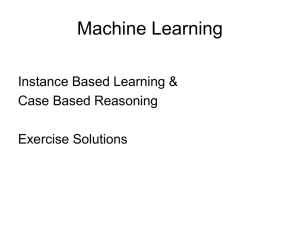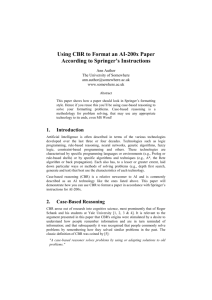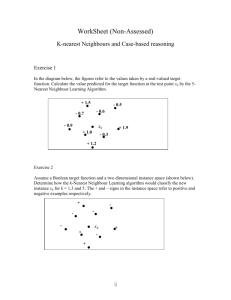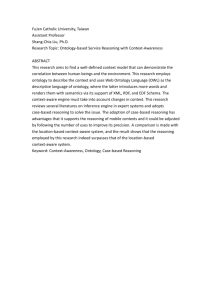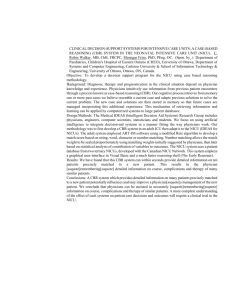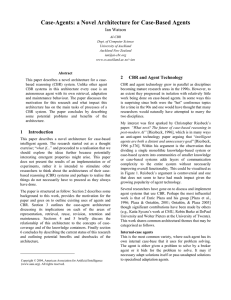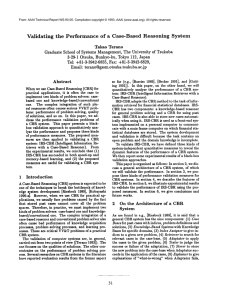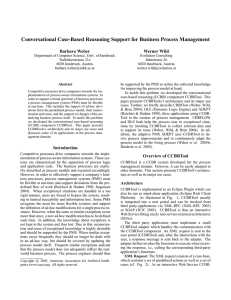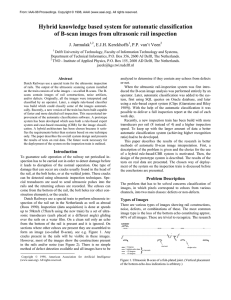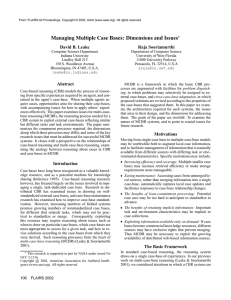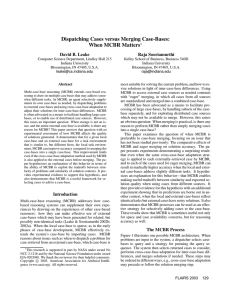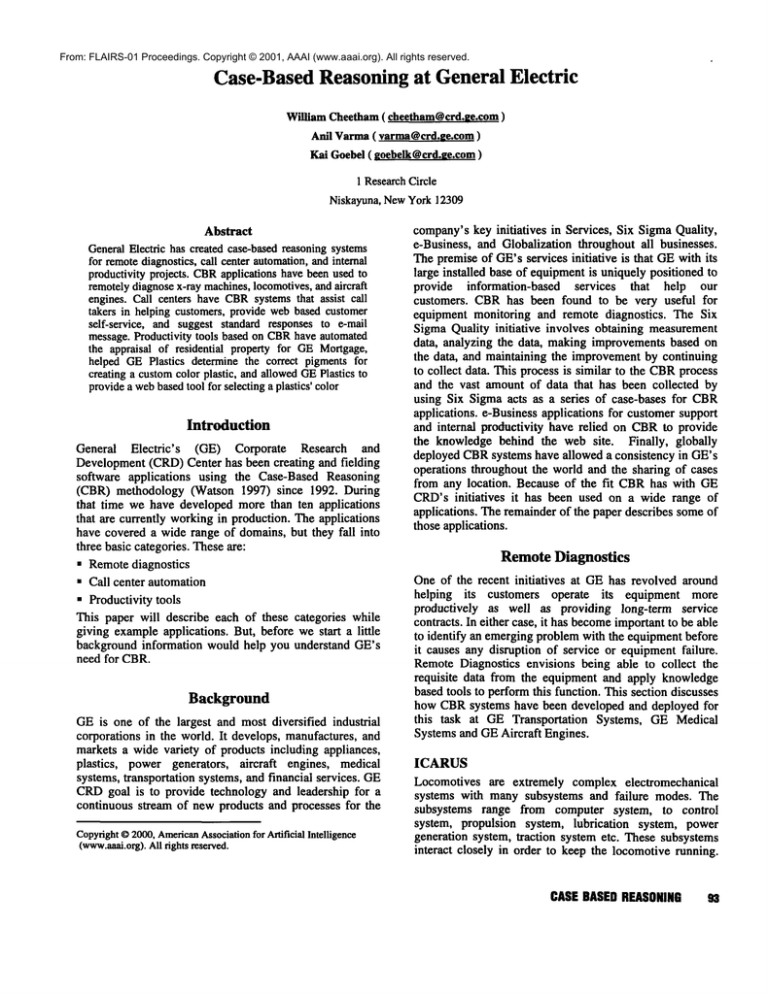
From: FLAIRS-01 Proceedings. Copyright © 2001, AAAI (www.aaai.org). All rights reserved.
Case-BasedReasoning at General Electric
Wimam
Cheetham( cheetham@crd.ge.com
Anil Varma( varma@crd.ge.com
Kai Goebel( goebelk@crd.Ee.com
)
1 ResearchCircle
Niskayuna, NewYork 12309
Abstract
GeneralElectric has created case-basedreasoningsystems
for remotediagnostics,call center automation,andinternal
productivity projects. CBRapplications have beenused to
remotelydiagnosex-ray machines,locomotives,and aircraft
engines. Call centers have CBRsystems that assist call
takers in helping customers, provide webbased customer
self-service, and suggest standard responses to e-mail
message.Productivity tools based on CBRhave automated
the appraisal of residential property for GEMortgage,
helped GEPlastics determine the correct pigments for
creating a customcolor plastic, and allowedGEPlastics to
providea webbasedtool for selectinga plastics’ color
Introduction
General Electric’s
(GE) Corporate Research and
Development(CRD)Center has been creating and fielding
software applications using the Case-Based Reasoning
(CBR) methodology (Watson 1997) since 1992. During
that time we have developed more than ten applications
that are currently workingin production. The applications
have covered a wide range of domains, but they fall into
three basic categories. Theseare:
¯ Remotediagnostics
¯ Call center automation
¯ Productivity tools
This paper will describe each of these categories while
giving exampleapplications. But, before we start a little
background information would help you understand GE’s
need for CBR.
Background
GEis one of the largest and most diversified industrial
corporations in the world. It develops, manufactures, and
markets a wide variety of products including appliances,
plastics, power generators, aircraft engines, medical
systems, transportation systems, and financial services. GE
CRDgoal is to provide technology and leadership for a
continuous stream of new products and processes for the
Copyright
©2000,American
Association
for Artificial Intelligence
(www.aaai.org).
Allrightsreserved.
company’skey initiatives in Services, Six SigmaQuality,
e-Business, and Globalization throughout all businesses.
The premise of GE’sservices initiative is that GEwith its
large installed base of equipmentis uniquely positioned to
provide information-based
services that help our
customers. CBRhas been found to be very useful for
equipment monitoring and remote diagnostics. The Six
Sigma Quality initiative involves obtaining measurement
data, analyzing the data, making improvements based on
the data, and maintaining the improvementby continuing
to collect data. This process is similar to the CBRprocess
and the vast amount of data that has been collected by
using Six Sigma acts as a series of case-bases for CBR
applications, e-Business applications for customer support
and internal productivity have relied on CBRto provide
the knowledge behind the web site. Finally, globally
deployed CBRsystems have allowed a consistency in GE’s
operations throughout the world and the sharing of cases
from any location. Because of the fit CBRhas with GE
CRD’sinitiatives
it has been used on a wide range of
applications. The remainder of the paper describes someof
those applications.
RemoteDiagnostics
One of the recent initiatives at GEhas revolved around
helping its customers operate its equipment more
productively as well as providing long-term service
contracts. In either case, it has becomeimportantto be able
to identify an emergingproblem with the equipment before
it causes any disruption of service or equipmentfailure.
RemoteDiagnostics envisions being able to collect the
requisite data from the equipment and apply knowledge
based tools to performthis function. This section discusses
how CBRsystems have been developed and deployed for
this task at GE Transportation Systems, GE Medical
Systems and GEAircraft Engines.
ICARUS
Locomotives are extremely complex electromechanical
systems with many subsystems and failure modes. The
subsystems range from computer system, to control
system, propulsion system, lubrication system, power
generation system, traction system etc. These subsystems
interact closely in order to keep the locomotive running.
CASEBASEDREASONING 93
From a service point of view, however, the configuration
of any individual system can be changed or upgraded.
The objective of having remote diagnostics on locomotives
is to be able to quickly identify if an equipmentfailure has
already occurred, or is going to occur on-board the
locomotive that mayresult in a locomotivestranded on the
tracks. The cost to the railroad of an immobilelocomotive
on the tracks is quite high, and the associated productivity
losses can be even higher. The challenge in designing a
diagnostics systemfor locomotivesarises from the fact that
it is nearly impossibleto articulate the thousandsof rules it
would take to comprehensively cover the locomotive’s
failure modes. In addition, maintaining such a rule-base or
equivalent static knowledgebase to prevent obsolescence
wouldrequire a tremendous amountof ongoing effort.
Case-Based Reasoning was identified as a potential
approach to creating a maintainable diagnostic system.
Various legacy databases were studied to catalog the
sources of information that could provide case related
information. One significant source of information was
historical fault logs generated by the locomotive. These
were matched up against the repair history of the
locomotive to create cases. A case initially consisted of
faults logged up to fourteen days before a repair was
performed on the locomotive. There were 600 different
types of faults that could be logged, and about 600
different kinds of repairs that could be performed.
A new algorithm was developed to help the system learn
weights associated with fault patterns. Fault patterns that
were considered included individual faults, combinations
of faults, the numberof fault occurrences in a day as well
as the longest continuous span in days for which a fault
occurs. Learning weights allowed the system to isolate the
fault indicators that were truly relevant in indicating which
fix was to be performed. Cases matched based on weighed
features ensured that relevance was assessed on genuine
indicators and not noise.
The system (Varma and Roddy, 1999) took about
months to develop and was initially
deployed on 750
locomotives. Its success and failures at diagnosis were
tracked and used to check case quality as well as add more
high quality cases to the system. Overall, the system
performance continues to improve with time and it is
currently able to provide greater than 70%accuracy on
more than 75%of the problems.
ELSI
This section examines the use of a case-based diagnostic
system built for GE Medical Systems (GEMS).An Error
Log Similarity Index (ELSI) (Cuddihy and Cheetham
1999) was first conceived in the early 1990’ s to solve
diagnostic challenge with Computer Tomography (CT)
scanners. GEMShad built an infrastructure
to allow
service to dial in to imaging equipment and diagnose
94
FLAIRS-2001
failures while still on the phone with the customer. Once
the service engineer had taken a look at the equipment
remotely, the customers’ issues could often be resolved
over the phone. If parts and repairs were needed, the
service engineer could send out a field engineer with the
correct parts already in hand. Someof the most promising
diagnostic information on the machineswas in error logs
generated by the computer processes controlling the
machines. The error logs, however, had been primarily
designed as debugging tools for developers, not as
diagnostic tools for service technicians. The logs were not
well formatted, and contained a mix of normal status
messages and error messages. The messages were
documented one-by-one, yet equipment failures were
found to generate more complex cascades of errors.
Recognizing these combinations of error messages was
purely an art form practiced by the more experienced
service engineers. An automated system was needed to
find these patterns and catalog them, thus creating a
commonexperience base across service engineers. ELSI
set out to meet this challenge.
ELSI’ s primarily case-based approach also provided
platform independence (the system could be used on
different models and types of equipment), little need for
knowledge collection from the equipment designers, and
the ability to keep up with design changes as new cases
arrived.
ELSIis an 8-step process wherethe error logs are obtained
in step 1 and pre-processedin step 2. In step 3 the logs are
comparedto other logs with the same fix, and the largest
possible blocks of completely matchinglines are extracted.
Whena new case comes in to be diagnosed, its logs are
searched for all knownblocks, and its similarity to known
cases is determinedby reporting which past cases share the
most symptoms(after weighting) with the new case.
step 4, the blocks of error log are then given weights
inversely proportional to the numberof different kinds of
problems have generated the block. Blocks that appear
only for one fix are given the highest weight. Those that
appear for manydifferent fixes are thrown out altogether.
Steps 5-8 are concernedwith updating and reporting tasks.
Using a "confidence" memberfunction (Cheetham 2000)
increased the accuracy and lowered the maintenance
requirements of the system. The confidence measure
played a key role in enabling ELSI to be handed off to
users with limited computing skills, where they added
hundreds of newcases and ran diagnostics on thousands of
problems over several years without requiring major help
from the system developers.
Aircraft Engine Monitoring
The CBRapplication shown here dynamically monitors
aircraft engines based on sensor readings taken from the
engine to provide an early alarm to aircraft fleet
management organization
about abnormal engine
conditions. To provide early warnings with little false
positive alarms the engine’s operating region (the
"normal"case) is continuously updated. This is in contrast
to the approach taken by other aircraft engine CBR
systems (e.g., Managoand Auriol, 1995) which focus
static fault diagnosis.
It is desirable to be able to detect abnormalbehaviorbefore
it causes costly secondary damageor results in equally
undesired engine shutdowns. To that end, service providers
have long tracked the behavior of engines by measuring
and analyzing a multitude of system parameters to become
aware of changes that might be indicative of developing
failures. However, often faults may not be recognized
distinctively because the "normal" operation condition
varies unpredictably. This is due in part to large amounts
of noise, poor corrections of first principle models or
regression models, changes of schedules, maintenance,
poorly calibrated and deteriorating sensors, faulty data
acquisition, etc. In addition, thermal, chemical, and
mechanical wear degrades the performance of the engine.
Although these changes are expected, they are hard to
predict with necessary accuracy because they are driven to
a large degree by a whole host of external factors. For
example, the effect of maintenance, such as replacement of
parts, is very hard to capture. To retain desirable
classification properties these changesmust also be echoed
in changesof the case-base.
Wedevised an approach for adaptive CBR(Bonissone et
al, 1999), which allows the clusters of cases to adapt to
changing environments. In the context of aircraft engine
monitoring, cases were defined as one cluster of normal
and one or several clusters of abnormal behavior. The
center can move and their shape can vary. This was
accomplished using slow exponentially-weighted moving
average filters that updated the cluster centroid with
information from any new data point and fuzzy clustering
that allowed the shape of the clusters to be adaptable over
time, respectively. After choosing the initial numberof
clusters, their position and membership,the adaptation of a
cluster is performed with the filter. The adaptive CBR
schemewas tested with historical gas turbine data.
The tool was developed over a 15 month time span and is
currently in use. After training, the system was used for
classification of on-line test data. Thefalse negative rate is
as low as with traditional trending tools (none observed
with the test data available) and the false positive rate
improved from 95%to less than 1%.
Call Center Automation
GE has manycall centers that were created to help our
customers. The people in the call center will answer
questions, help diagnose problems, schedule appointments,
and provide a wide range of information and services.
CBRhas been used to provide improved customer service
and new ways to meet our customers needs. This section
will describe three of these projects.
Call TakerEducation
GE Appliances provides a variety of customer services
over the phone. One of these is group of about 300 field
service order takers whoschedule field service personnel
to visit customers’ homes. It was found that about 20%of
the time a field service representative arrived at the home
all that was needed was to educate the customer about the
appliance. This education could usually have been done
over the phone saving time for the customer and field
service representative. However,the field service order
takers were not trained to diagnose and explain issues over
the phone. This training was difficult because of the large
number of appliances that can be serviced, complexity of
modernappliances, and most importantly the high turnover
in the order takers. The solution to this was to create a
CBRsystem to assist the order takers in diagnosing the
appliances.
The CBRsystem created used eGain’s k-Commercetool
(Thomaset. al. 1997). Separate case bases were created for
each type of appliance. A team of design engineers, phone
support technicians, and computer scientists worked on
each case base. A pilot test was run for 3 monthswith 12
order takers providing feedback and suggestions on howto
improve the system. Twopeople were assigned to maintain
the knowledge in the case base and the process for
introducing a new appliance now includes a step where
diagnostic cases are placed in the case base before the
product is released to market.
The system was deployed to the 300 order takers in June of
1999. The percentage of calls that could be correctly
answered over the phone, without sending a field service
representative, increased from 3.9%to 12.3%. Surveys of
customer satisfaction also showedthe customer preferred
having their issues solved without the need for a house
visit.
WebSelf-Service
After the call taker support tool provedsuccessful, the next
step was to make the tool available to our customers by
placing it on a public web site. This wouldallow customers
direct access to the information they need. Graphics and
other forms of information that could not be used over the
phone could also be placed in the CBRsystem on the
public web-site.
Even though the call taker support tool was a web-based
application there were still somechanges that were needed
to deploy it on the web. The user interface needed to be
improved.The cases contained jargon, instructions for the
order takers, and proprietary information that all had to be
removed. Newgraphics and information needed to be
added. Finally, there needed to be a way for customers to
CASEBASEDREASONING 95
get help if they could not find what they wanted in the
case-base.
The modifications needed were madein a few months, but
the case base is constantly growing and changing. The web
self-service
tool was made available
on the
www.geapplianees.comweb site in early 2000. If issues
were not in the eases-base customers could phone or email
the call center with the question. The email acted as an
indication of which cases were the most important to add.
eMail Response Automation
The down side of asking people to send in email with
questions is that you then have to answer all the email
messages. Wefound that it actually took longer for a
person at the call center to answer an email messagethan a
phone message. So, a way to help reply to the emaii was
needed.
There are several commercial tools for automating the
response to email messages. Weselected Cisco’s eMail
Managertool. This tool stores replies to frequently asked
questions so that they can be reused on future similar
questions. In order to select the appropriate reply a
decision tree is created whereeach nodein the tree is a rule
based on the text in the email message. Each leaf node in
the decision tree specifies a set of replies that can be used
to answer that specific type of email message. This is
really another form of CBR.
The email application was deployed to the GEAppliances
call takers in June of 2000. The consistency of answers has
improved because now people are sending out approved
answers instead of hand crafting every reply. The average
time to reply to a message has dropped 40%. And, over
99%of all email messages are answered in less than 5
hours
Productivity Tools
In addition to remote diagnostics and call center
applications, CBRhas been used to automate processes
that were previously done by hand in a manner that was
similar to ease-based reasoning. This section describes two
of these applications
then shows how the second
application was transformed from an internal productivity
tool to an external e-Businesstool.
Property Valuation
GE Mortgage used to originate mortgages and buy
packages of mortgages for single-family residential
properties on a secondary market. In either case, it is
important to get an appraisal of the property before
granting or purchasing the mortgage. It wouldbe useful to
96
FLAIRS-20Ol
have an automatedwayof creating the appraisal in order to
grant on-line mortgages or purchase packages that can
include 1000 mortgages.
The traditional appraisal process uses a CBRapproach.
The appraiser wouldselect three to five properties similar
to the subject. Each property selected would have their
sales price adjusted based on differences betweenit and the
subject property. Then the adjusted sales prices wouldbe
combinedto produce a price estimate for the subject. In
1994, we created a software tool that wouldautomate this
process (Bonissone and Cheetham1998). The tool worked
for properties in California. The case-base consisted of
every property that had sold in California during the
previous five years. The goal of the project was to
determine the case selection, sales price adjustment, and
sales price combinationtechniques that would produce the
lowest averageerror in the price estimate.
The tool that was created produced a price estimate and a
confidence in that estimate. The confidence value
predicted if the error in the estimate would be high,
medium,or low. Analternative could be used to appraise a
property that had a high predicted error. This could be
another semi-automated system or sending a human to
appraise the property. The CBR system had a low
predicted error on 63%of the properties on which it was
tested. The average error on this 63%was 5%.
Color Matching
One of the services that GEPlastics provides is coloring
the plastic they sell any color that a customer would
request. There are over 40 colorants and usually four or
five are used to create a customcolor. Selecting the correct
formula, which consisted of colorants and the amountsof
those colorants, was a time consumingprocess. Since there
was no algorithm to go from a request to a formula the
color matchers relied on their experience. Theykept a set
of filing cabinets that had 2" by 3" chips of every color
plastic they created. Whena new match was needed they
opened the appropriate drawer and selected the most
similar colors that had been madein the past. Each chip
was numberedand the formula for the chip was stored in
another filing cabinet. If one of the chips selected was
appropriate they were done. If not they took the formula of
the most similar chip and repeatedly adapted it until it was
acceptable. This method is CBR(Watson 1998) where the
filing cabinet acted as a case-base.
Wecreated a software tool to automate this process
(Cheetham and Graf 1997). The plastic chips from the
filing cabinet had their colors recorded numerically by
using a machine called a spectrophotometer. The colors
were combined with the formulas from the other filing
cabinet to create a case-base. The tool created allowed for
the efficient selection of the best previous color from the
case-base. Color theory was used to create algorithms that
adapted the amountsof the colorants selected if the best
match was not satisfactory. The selection and adaptation
used fuzzy logic technology to optimize multiple factors
that were all important in determining the best match.
Someof these factors included color, cost, opacity, and
manufacturability. Wheneverthe adaptation algorithms
were used to create a new color, that color was stored in
the case-base for possible future use.
The tool began being used in 1994 at one manufacturing
site for one type of plastic. Since then it has expandedto
other types of plastic and multiple sites throughout the
world. It was very important to our customers that we get
the color matches done quickly and this reduced the time
needed to create a color match significantly. Furthermore,
the tool was good at using low cost colorants, which
decreased the cost to producethe plastic.
ColorXpress
Havinga tool that creates lower cost color matchesfaster is
good, but it would be better to completely eliminate the
need for a color match. Since we had already created the
case-base and selection algorithms so that they were easy
to use, why not allow our customers to select their own
colors from our case-base?
ColorXpress, www.gecolorxpress.com, is a web site that
offers customers an opportunity to both color match and
order standards on-line. In the past, our customers used a
variety of ways to select the color for their products then
sent us the color to be matched. Now,ColorXpress can be
used to select their colors. Anyitem selected has already
been matchedand a sample can be sent to the customer in
48 hours. This both increase the speed of the match and
eliminates the need for may custom matches. This also
shows how an internal
productivity
tool can be
transformed into an external e-Business tool.
Conclusion
Wehave shown examples of applications that use CBRfor
remote diagnostics,
call center automation, and
productivity tools. Manyfactors point to an increase in the
use of CBR.First, GE and other companies are shifting
from producing goods to performing services. If these
services are automated the cost of performing service
drops and companiesrealize greater profits. Second, the
emphasis on data in quality initiatives combinedwith the
decrease in cost of sensor and data storage have produced
vast amounts of data that can be used in CBRsystems.
Third, the advent of the web as a commonuser interface
has decreased the cost of deploying automated systems.
Fourth, large companieswhoare looking to get economies
of scale and globally available services can achieve
savings from the automation provided by single CBR
systems that can be deployed globally. Finally, by sharing
best practices and lessons learned in the creation of these
automatedsystems the cost to create future systems can be
reduced. Past mistakes can be avoided and the best features
on a previous system can be replicated in a newone.
The authors hope that the best practices and lessons shared
in this paper can be used as a case base for successful CBR
projects. In order to create a newCBRapplication, simply
find the previous application that is the most similar and
apply that technique with someadaptations.
References
Bonissone, P., Cheetham, W., 1998. Fuzzy Case-Based
Reasoning for Residential
Property Valuation. In
Handbookof Fuzzy Computation Section G14.1. Bristol,
UK:Institute of Physics Publishing.
Bonissone, P., Chen, Y., Goebel, K., Kedhkar, P., 1999.
Hybrid Soft Computing Systems: Industrial
and
Commercial Applications. In Proceedings of the IEEE
87(9): 1641-1667.
Cheetham, W., 2000. Case-Based
Confidence. European Workshop
Reasoning,Trento, Italy.
Reasoning with
on Case-Based
Cheetham, W., Graf, J,, 1997. Case-Based Reasoning in
Color Matching. Second International
Conference on
Case-Based Reasoning, 1-12. RI, USA.
Cuddihy, P., Cheetham, W., 1999 ELSI: A Medical
Equipment Diagnostic System. Third International
Conference on Case-Based Reasoning 415-425. Munich,
Germany.
Manago, M., Auriol, E., 1995 Using Data Mining to
Improve Feedback from Experience for Equipment in the
Manufacturing & Transport Industries. lEE Colloquium on
Knowledge Discovery and Data Mining. Digest No.
1996/198.1/1 -1/9.
Thomas, H., 1997. NewTechnology Bliss and Pain in a
Large Customer Service Center. Second International
Conference on Case-Based Reasoning, 166-177. RI, USA
Watson, I., 1997. Applying Case-Based Reasoning:
Techniques for Enterprise Systems, San Francisco, Cal.:
Morgan KaufmannPublishers.
Watson, I., 1998. CBRis a methodologynot a technology.
In, Research &Developmentin Expert Systems XV. Miles,
R., Moulton, M., & Bramer, M. (Eds.), 213-223, Springer,
London.
Varma, A., Roddy, N., 1999. ICARUS: A Case-Based
System for Locomotive Diagnostics.
Engineering
Applications of Artificial Intelligence Journal.
CASEBASERREASONING 97

